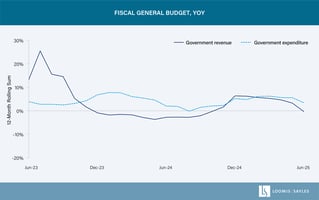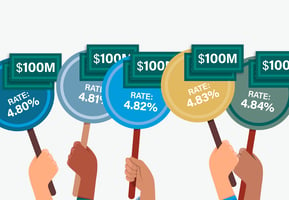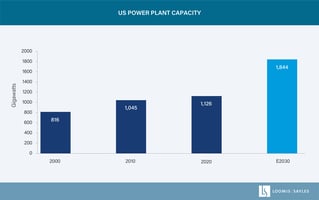
Loomis Sayles Core Plus Fixed Income:
Navigating Dynamic Markets
with Tactical Flexibility
WRITTEN BY
PETER PALFREY, CFA
Portfolio Manager
RICK RACZKOWSKI
Portfolio Manager
MICHAEL GLADCHUN
Associate Portfolio Manager
The global credit cycle is a perpetual force, influencing interest rates, credit availability and capital markets pricing.
For core plus managers who seek to generate total return by balancing quality and liquidity versus risk, correctly identifying the drivers of a cycle can be a challenge but can also create opportunity.
In our view, navigating dynamic market cycles requires a flexible mandate and the ability to combine rigorous macroeconomic insight with security-specific fundamental research. Loomis Sayles Core Plus Fixed Income is a benchmark-aware strategy that, through tactical portfolio allocations, seeks to add incremental return in stable-to-improving markets and preserve principal during adverse markets.
When market conditions are considered “constructive” and risk/return measures warrant, the strategy typically pursues a yield advantage over the Bloomberg US Aggregate Bond Index (the index), while also positioning with relative overweights to sectors the team deems to be trading at attractive valuations, and potentially at an underweight to the various government sectors.
Key Takeaways
1. Loomis Sayles Core Plus Fixed Income is a benchmark-aware strategy that seeks, through tactical portfolio allocations, to add incremental return in stable-to-improving markets and preserve principal during adverse markets.
2. Every fixed income portfolio has inherent macroeconomic risks. We are intentional about how we position for these risks, using our top-down assessment of the credit cycle to determine overall portfolio quality, liquidity and price transparency. This top-down analysis ultimately helps to determine our sector, security, yield curve and duration positioning.
3. Relative and absolute risks are monitored continuously, using both traditional risk metrics and forward-looking scenario analysis for a more nuanced perspective.
Often, this can mean a relative overweight to the various spread sectors within the index, as well as selected typically higher-yielding or more cheaply valued “plus” sectors, including high yield, bank loans, collateralized loan obligations (CLOs), emerging market, high yield and non-US-dollar-denominated securities. During periods that call for more defensive positioning, the strategy generally adopts a higher-quality, more benchmark-like posture, which may include overweight positioning to the US government sector and potentially agency mortgage-backed securities as a higher-yielding proxy for the government market. A challenge lies in determining where to deploy capital at any given time for the desired mix of portfolio quality, liquidity and price transparency. As such, our investment process begins with a top-down assessment of the global macroeconomic environment and capital market drivers—a view that we use to determine sector, security, yield curve and duration positions.
With this nimble approach, we believe the Loomis Sayles Core Plus Fixed Income strategy can achieve strong returns through a range of economic and market environments.
Core Plus Fixed Income Composite
Performance as of 31 December 2024

Source: Loomis Sayles and Bloomberg.
Returns for multi-year periods are annualized. Gross returns are net of trading costs. Net returns are gross returns less effective management fees. Indices are unmanaged and do not incur fees. It is not possible to invest directly in an index.
Past performance is no guarantee of future results.
The Importance of a Macro View
For us to confidently position the portfolio, we must first analyze the macroeconomic themes shaping the investment landscape. Drawing on Loomis Sayles’ deep macroeconomic and sovereign research capabilities, we continuously assess key global macro factors such as GDP growth, monetary and fiscal policy, inflation, supply/demand dynamics of government bond markets, credit availability and politics, which are typically driven by the world’s major developed economies. Our view of the overall global credit cycle helps us determine a balance between our goals of return maximization and capital preservation and, accordingly, how to position the portfolio relative to the benchmark (e.g., up or down in quality, liquidity and price transparency).
While the US economy is often a major driver of the global economic cycle, other major developed and emerging markets will often play a significant role in the global credit cycle. Additionally, the various economies across the globe do not necessarily progress through the cycle in lockstep. We believe our ability to identify “mini cycles” and assess credit conditions in individual economies is critical. We benefit from the insights of our macro strategists, our credit research analysts across the globe and our sovereign analysts, whose knowledge of local markets helps us pinpoint where opportunities and risks may exist.
Tactical Sector Allocation
Once our macro strategies team has identified credit cycle themes, tactical use of sectors—including out-of-benchmark exposure—helps us to target opportunities and portfolio themes. The strategy has the flexibility to invest up to 20% in high yield and up to 10% in non-dollar investments. Investment grade CLOs, dollar-pay emerging markets debt and TIPS (Treasury inflation-protected securities) are additional examples of out-of-benchmark security types.
When making sector allocations we are mindful of a cycle’s idiosyncrasies: an effective strategy for one period of credit repair, for example, may not be optimal during the next phase of credit repair. We may tilt toward, or away from, specific industries based on the distinct drivers of the current credit cycle.
For example, in 2008 we tilted away from industries with exposure to housing, including banks, homebuilders and home improvement retailers. In 2021 and 2022, we tilted toward industries leveraged to reopening economies and the phasing out of pandemic-induced lockdowns, such as autos, airlines and hotels. To make informed decisions, we draw on our own experience and firm resources, including specialized sector teams (asset class strategy groups comprised of portfolio managers, research analysts and traders). We then implement our sector strategy through fundamental, bottom-up security selection. In partnership with Loomis Sayles’ credit, sovereign and securitized research analysts, we look to identify disconnects between market pricing and intrinsic value, and determine appropriate position sizes based on relative valuation, issuer volatility and liquidity.
GLOBAL CREDIT CYCLE
The chart below illustrates the Loomis Sayles Core Plus Fixed Income strategy’s tactical use of sectors. To help enhance return potential, credit and more pro-cyclical non-dollar exposure is more often added during periods of credit repair and recovery. During the expansion phase of the credit cycle, a theme of “up in liquidity and price transparency” coupled with more of a high-quality yield focus, may be deemed appropriate. During the late expansion phase, the strategy is generally positioned up in quality and liquidity, with a bias toward higher-quality duration—often with a more similar profile to that of the index.
Loomis Sayles Core Plus Fixed Income Composite Sector Allocation
Source: Loomis Sayles. Data based on quarterly calculations during the period of 31 March 2006 through 30 June 2024. Period of data begins in 2006 in an effort to show as many full credit cycles as possible within a readable graphic. Sector allocations for longer-term periods are available upon request.
Due to active management, sector allocations will evolve over time.
Phases of the credit cycle are approximate and have been estimated by the Loomis Sayles Core Plus Fixed Income team. Please see the end of this paper for more detailed information.
Plus Sectors: The Tool Kit
Though plus sectors are often thought of as increased risk/reward areas, we think these sectors can sometimes help reduce portfolio risk. Examples of possible risk diversifiers include TIPS (inflation risk), defensive currencies (e.g., the Japanese yen, the Swiss franc, euro) and floating-rate securities during periods of rising rates (bank loans, CLOs). Overly constrained mandates can force managers to take less attractive positions because of limited flexibility, thereby introducing unintended risk into a portfolio. Likewise, overly flexible mandates biased to reach for yield may introduce too much tracking error and deliver inconsistent returns. We consider a broad opportunity set, but in the context of where we are in the credit cycle and whether we think valuations are compensating us for a higher potential return per unit of risk. Allocations to plus sectors, detailed in the chart below, have averaged 25% of the strategy’s market value since 31 March 2006.1
Loomis Sayles Core Plus Fixed Income Composite Plus Sectors Allocation
Source: Loomis Sayles. Data based on quarterly calculations during the period of 31 March 2006 through 30 June 2024. Period of data begins in 2006 in an effort to show as many full credit cycles as possible within a readable graphic. Sector allocations for longer-term periods are available upon request.
Due to active management, sector allocations will evolve over time.
Phases of the credit cycle are approximate and have been estimated by the Loomis Sayles Core Plus Fixed Income team. Please see the end of this paper for more detailed information.
We employ plus sectors in seeking to construct pro-cyclical, offensive portfolio positions and to help mitigate specific market risks, as described in the following case studies.
High Yield Corporate Bonds, Bank Loans & CLOs:
We believe high yield can be attractive during periods of the economic cycle that we characterize as repair, recovery and expansion. It generally offers a yield advantage over many other fixed income sectors and can benefit from capital appreciation when credit spreads tighten. Because high yield bonds generally have a yield “cushion,” they can exhibit reduced duration sensitivity and may serve as a defensive hedge against rising rates. High yield bonds are lower in the capital structure than bank loans, and we consider them high-beta assets due to their increased credit and liquidity risk. Bank loans hold a senior position in the capital structure, and while this can limit their upside potential, we believe it can be a valuable defensive credit feature in later-stage economic expansions. Investment grade CLOs can offer an additional layer of diversification and reduced idiosyncratic risk relative to bank loans and can be traded daily. Both bank loans and CLOs boast floating-rate coupons, which tend to be beneficial when rates are expected to rise.
Non-US Investments:
Today, roughly 74% of global GDP comes from outside the US.2 Our guidelines allow us to follow economic growth opportunities around the world and to take targeted exposure outside US fixed income markets. When the risk/return prospects appear particularly compelling, we may deploy non-US investments offensively to emphasize directional themes within the global credit cycle. We can also use the allocation defensively in seeking to offset or hedge against other risk exposures in the portfolio. Loomis Sayles Core Plus Fixed Income is able to invest directly in global currencies, non-dollar sovereign bonds (unhedged) and dollar-denominated bonds of non-US issuers
(Yankee bonds).
- Currencies: Currencies can be utilized to express pro-cyclical or defensive views of global markets, to go up or down in quality and liquidity, and to take advantage of price dislocations or perceived overreactions in the market.
- Non-dollar denominated bonds and Yankee bonds: We can use these tools to invest in countries and corporations whose balance sheets, bond yields or bond market supply/demand dynamics appear attractive.
Risk Management
When managing a benchmark-aware strategy that seeks to preserve principal in adverse markets and add excess return in stable-to-improving markets, we believe risk control and downside mitigation are paramount. Relative and absolute risks are monitored continuously, and our ability to position similar to, or different from, the benchmark is central to risk management efforts. While we do not manage to tracking error, we are mindful of the benchmark and tend to only add to tracking error when we feel we are being compensated to do so. The strategy typically targets a minimum 25% allocation to the US government sector. This positioning helps deliver a source of liquidity and also provides a directional link to interest rate movements. Changes in interest rates inform how we manage portfolio duration and yield curve exposure, which we find especially important when the Federal Reserve is very active. When we believe interest rates are approaching a peak and may begin to decline, we typically increase Treasury contribution to duration. In contrast, when rates are too low and are likely to rise, we often decrease Treasury contribution to duration, use TIPS as a substitute for nominal US Treasurys and/or can utilize more floating-rate instruments to shorten duration.
In volatile environments, or late expansion environments when the risk of moving into downturn is higher than normal, we typically favor high-quality, more liquid government securities. During periods of economic repair and recovery, we tend to favor spread sectors that typically offer higher yield advantage per unit of risk. We are mindful of traditional risk measures and historic correlations between asset classes but recognize that at inflection points in the credit cycle, overreliance on backward-looking data can lead to poor decision making. We regularly test our portfolio with forward-looking scenario analysis tools to form a more nuanced and dynamic view of risks to the portfolio and to frame discussions regarding potential positioning changes.
The chart below shows the strategy’s three-year rolling excess return and tracking error through the different phases of the credit cycle.
Loomis Sayles Core Plus Fixed Income Composite Three-Year
Rolling Excess Return (Net) & Tracking Error Data

Source: Loomis Sayles. Data begins in December 2009 based on 3-year rolling quarterly calculations inclusive of the period of 31 December 2006 through 31 December 2024. Period of data begins in 2006 in an effort to show as many full credit cycles as possible within a readable graphic. Three-year rolling excess return and tracking data for longer-term periods are available upon request.
Gross returns are net of trading costs. Net returns are gross returns less effective management fees. Excess return calculated using the Composite benchmark, the Bloomberg US Aggregate Index. Please see the standard trailing returns for the Composite included earlier in the paper. Phases of the credit cycle are approximate and have been estimated by the Loomis Sayles Core Fixed Income Plus team. Please see the end of this paper for more detailed information.
Past performance is no guarantee of future results.
Conclusion
Today’s ever-evolving credit cycles and complex global markets require flexibility. Our benchmark-aware, research-intensive investment style combines macroeconomic insight, changing tactical allocations and security-specific expertise to help meet this need. As a portfolio management team, we have managed through multiple credit cycles and have experienced the dynamic behavior of bond duration, yield curves, currencies and sectors. Drawing on this experience and Loomis Sayles’ research arsenal, we seek to populate the portfolio with what we believe are the best ideas for each distinct market environment and strive to deliver principal preservation and solid risk-adjusted return to our investors.
Authors
Peter Palfrey, CFA
Portfolio Manager
Rick Raczkowski
Portfolio Manager
Michael Gladchun
Associate Portfolio Manager
Endnotes
1 As of 31 December 2024.
2 Bloomberg Pro; 2023 World Bank data.
Credit Cycle Regime Periods
As of 31 December 2024.
Regime periods as shown on charts earlier in the paper are determined by the Loomis Sayles Core Plus Fixed Income team based on a variety of subjective and objective factors, including past economic and asset performance metrics.
Views and opinions expressed reflect the current opinions of the investment team, and views are subject to change at any time without notice. Other industry analysts and investment personnel may have different views and opinions.
Important Disclosure
This marketing communication was originally published in September 2024. We have updated the content as necessary and otherwise believe the information is current and relevant.
This marketing communication is provided for informational purposes only and should not be construed as investment advice. Investment decisions should consider the individual circumstances of the particular investor. Any opinions or forecasts contained herein reflect the subjective judgments and assumptions of the authors only and do not necessarily reflect the views of Loomis, Sayles & Company, L.P. Investment recommendations may be inconsistent with these opinions. There can be no assurance that developments will transpire as forecasted and actual results will be different. Information, including that obtained from outside sources, is believed to be correct, but we cannot guarantee its accuracy. This information is subject to change at any time without notice.
Market conditions are extremely fluid and change frequently.
Diversification does not ensure a profit or guarantee against a loss.
Any investment that has the possibility for profits also has the possibility of losses, including the loss of principal.
There is no guarantee that the investment objective will be realized or that the strategy will generate positive or excess returns.
Past market experience is no guarantee of future results.
Performance data shown represents past performance and is no guarantee of, and not necessarily indicative of, future results.
For additional information on the Loomis Sayles Core Plus Fixed Income Composite, please request the most recent presentation book with GIPS report.
This material was prepared for an institutional audience, it is not intended for a retail investor.
LS Loomis | Sayles is a trademark of Loomis, Sayles & Company, L.P. registered in the US Patent and Trademark Office.
SAIFzrt04d9u

